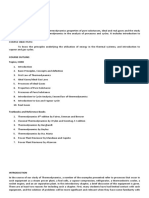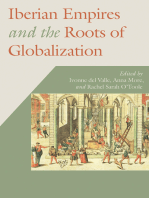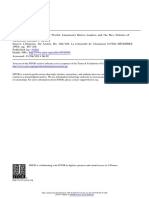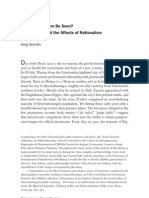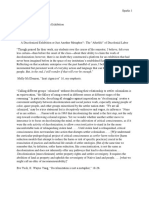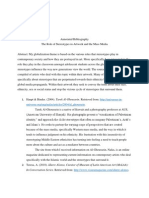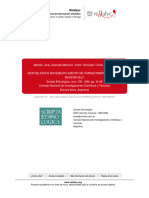Professional Documents
Culture Documents
Where Is Ana Mendieta Identity Performat
Where Is Ana Mendieta Identity Performat
Uploaded by
Maja MenezioOriginal Description:
Original Title
Copyright
Available Formats
Share this document
Did you find this document useful?
Is this content inappropriate?
Report this DocumentCopyright:
Available Formats
Where Is Ana Mendieta Identity Performat
Where Is Ana Mendieta Identity Performat
Uploaded by
Maja MenezioCopyright:
Available Formats
Where is Ana Mendieta?
: Identity, Performativity, and Exile by Jane Blocker
Review by: Jane Desmond
NWIG: New West Indian Guide / Nieuwe West-Indische Gids, Vol. 75, No. 1/2 (2001), pp. 128-
130
Published by: BRILL on behalf of the KITLV, Royal Netherlands Institute of Southeast Asian and
Caribbean Studies
Stable URL: http://www.jstor.org/stable/41850100 .
Accessed: 30/09/2014 11:11
Your use of the JSTOR archive indicates your acceptance of the Terms & Conditions of Use, available at .
http://www.jstor.org/page/info/about/policies/terms.jsp
.
JSTOR is a not-for-profit service that helps scholars, researchers, and students discover, use, and build upon a wide range of
content in a trusted digital archive. We use information technology and tools to increase productivity and facilitate new forms
of scholarship. For more information about JSTOR, please contact [email protected].
BRILL and KITLV, Royal Netherlands Institute of Southeast Asian and Caribbean Studies are collaborating
with JSTOR to digitize, preserve and extend access to NWIG: New West Indian Guide / Nieuwe West-Indische
Gids.
http://www.jstor.org
This content downloaded from 129.194.8.73 on Tue, 30 Sep 2014 11:11:20 AM
All use subject to JSTOR Terms and Conditions
128 NewWest Gidsvol.75no.1 & 2 (2001)
IndianGuide/NieuweWest-Indische
Cabrera,Lydia,1992.El monte: vititi
Igbo,finda,eweorisha, nfinda.(Notassobrelas
yelfolklore
, lassupersticiones
la magia
religiones, delosnegroscriollos
ydelpueblode
Cuba).Miami:Ed.Universal.
[Orig.1968.]
DeschampsChapeaux, Pedro,1971. El negro
enla economía
habañera delsigloXIX.La
Habana:Ed.Union.
Howard, Philip
A.,1998.Changing
History:
Afro-Cuban CabildosandSocieties
ofColor
intheNineteenth BatonRouge:Louisiana
Century. StateUniversityPress.
Landes,Ruth,1992.TheCityofWomen.Albuquerque ofNewMexico.[Orig.
: University
1947.]
Matory,James Lorand,1999.TheEnglish ofBrazil:OntheDiasporic
Professors Roots
oftheYorubaNation.
Comparative inSociety
Studies andHistory 41:72-103.
Ortiz,Fernando,1917.Hampaafrocubana:Losnegros Madrid:
brujos. Ed.America.
Whereis Ana Mendieta?:Identity and Exile. JaneBlocker.
, Performativity,
DurhamNC: Duke University Press,1999. xvi + 166 pp. (ClothUS$ 49.95,
PaperUS$ 17.95)
JaneDesmond
AmericanStudies
Department
ofIowa
University
IowaCityIA 52242,U.S.A.
<[email protected]>
Cuban-bornartistAna Mendieta'slifeand worksformtheimpetusforthis
carefullycraftedyetultimatelyunderhistoricized book by arthistorianJane
Blocker.Mendietastagedpowerful, evocative imagesusingearth,sand,fire,
water,flowers,and herown,often-nude, body.As a youngadolescentfrom
themostelitestratum of Cuban society,Mendietaimmigrated to theUnited
in
States 1961 as partof "Operation Pedro Pan" - thepost-Revolution reset-
tlingof Cuban childrensponsoredby U.S. corporations with the assistance
oftheCatholicChurchandtheStateDepartment. She was raisedin Iowa and
educatedin visual artsat theUniversity Iowa, and producedmostof her
of
worksinIowa, New York,andMexico fromtheearly1970suntilheruntime-
ly and suspiciousdeathin New Yorkin 1985.
Mendieta'sworksinvestigatedmanyof thç key aestheticand political
issuesof the1970s avant-garde,whentheprimacyof paintingand sculpture
gave way to theanti-object,anti-commodification initiativesof earthworks
and theembodiedartexplorationsof performance like ChrisBurden
artists
This content downloaded from 129.194.8.73 on Tue, 30 Sep 2014 11:11:20 AM
All use subject to JSTOR Terms and Conditions
BookReviews 129
andCarolee Schneemann.Mendieta'sworkswereusuallytransient, site-spe-
cificpiecesinvolvingimagesofthefemaleform,oftenmarkedbytheresidue
of burntash or thedematerializing effectsof waves on sculptedsand. Like
muchperformance and conceptualartof thetime,thesepieces wereactually
seen by fewpeople butbecameknownto a widerpublicthrough photodoc-
umentation. Many of the photos are included in thisbook, and the powerof
the images,withtheirtracingsof femalebody images on leaf or stone,or
burntintothegrass,comes through even in smallblack and whitereproduc-
tions.Mendietais an artistto be reckonedwith.
JaneBlocker'sgoal in Whereis Ana Mendieta?is to takeup thechallenge
of writingabout such elusive artworksand, more particularly, to place
Mendietahistorically in a way thatilluminates whatBlockersees as thecon-
stitutivetensionsand contradictions in herartwork.She dividesherdiscus-
sions into five chaptersfocusedaroundconceptualissues and Mendieta's
artist'smaterials:Fire,Earth,Exile,Travel,andBody.Detaileddiscussionsof
individualartworksanchoreach chapter.Findingpreviouscriticalassess-
mentsof Mendieta'sworktoo simplisticforeitheressentializing heridentity
or accusingherofessentialism, Blockeroffersa newapproachbydrawingon
theoriesof performativity developedby criticssuchas JudithButler.Butler
suggeststhatcategoriesof social identity are activatedthrough therepetition
and mis-repetition of semioticallymarkedactionsthatgain theirmeanings
throughreferenceto pre-existing codes of signification shotthroughwith
power.
Blocker'sapproachenablesherto interpret theartworks as rhetoricalacts
ratherthanas artobjects. She assertsthatMendietamobilizespotentially
essentializingdichotomies(nature/culture, home/exile, earth/nation,female/
male,white/non- white)preciselyto unsettlesuchdichotomiesby rendering
thembothfamiliarand uncannyat thesame time.
The performative approachis partof the book's strength, enablingthe
authorto movefroman analysisof selectedworkstobroaderissuesofhome,
exile, and nation.But,despitethisreach,theanalysesremainparadoxically
hermetic.Withtheexceptionof some reportsof critics'interpretations, we
hearalmostnothingaboutthereceptionof theseworks:How did heraudi-
ences reactto them?Did theyinfluenceotherartists?Instead,meaningsare
read offtheartworksthemselves,througha criticalapproachto Mendieta's
ownwritings, andthrough a consideration ofMendieta'slife(and publicself-
presentation) as a Cuban exile.
WhileBlockerattempts toputtheseelementsintoa dynamicinterplay, her
effortsare hamperedby an over-relianceon criticslike Edward Said and
Homi Bhabha formodels of nation,identity, and exile. As usefulas these
modelsare,theyneedto be broughtintoconversation withthespecificracial
and class dynamicsof the distinctivewaves of Cuban migrationsto the
United States in the 1960s, 1970s, and 1980s, the period duringwhich
This content downloaded from 129.194.8.73 on Tue, 30 Sep 2014 11:11:20 AM
All use subject to JSTOR Terms and Conditions
130 NewWest Gidsvol.75no.1 & 2 (2001)
IndianGuide/NieuweWest-Indische
Mendietalivedand workedin theUnitedStates.Also illuminating wouldbe
moreextensivediscussionof parallelsand distinctions betweenMendieta's
workand thatof otherCaribbeanor LatinAmericanartistsworkingin the
UnitedStatesat thesame time.
The importance ofsuchspecificity is especiallyapparentin Blocker'sdis-
cussionof theracial dynamicsof theworks.She tracesMendieta'sjourney
froma privileged(by class and Europeanorigin)positionin Cuba to a U.S.
experiencewithracismwhichled herto see herselfas otherssaw her,"non-
white,"and to embracetheterm"ThirdWorldWoman."This embraceof re-
positioning, and Mendieta'spro-active,anti-racist manipulationof U.S. cat-
egoriesis important. However,to fullyunderstand theconditionsofreception
of her work(and of herselfas a ThirdWorldwoman artistin the United
States),we mustbettergraspnotonlytheracial and class dynamicsof the
Cuba sheleft,butalso thecomplicatedracialcalibrations withinandbetween
immigrant communities. The social statusand powerof Cuban immigrants
fromthat1960s wave is important hereand becomes maskedby thecapa-
ciousnessof theterm"non-white."
Blocker'sextendedreadingof Mendieta'suse of "La VenusNegra"(The
Black Venus) legend,whichcloses the book, especiallywould have been
strengthened by a morehistorically anchoreddiscussion.Her statement that
"Mendieta'schoiceto associateherselfwiththeVenusNegra,withthenative
Indian,is a typicalstrategy by whichLatinosdefinetheiridentitiesrelative
to theproblematicsof race,politics,and nationhood"(p. 128) indicatesthe
difficultyof thisterrain.A color line is alive and well in Cuba, and among
Cuban-Americans,and is differently constructedfromthatin otherLatin
AmericancountrieslikeMexico.
Whatis therelevanceofthisbookto a potentialaudiencebeyondthepub-
lisher's"feminist/performance studies"designation?How can we place this
book in conversationwithotherbooks on Cuba, or on Caribbeanimmigra-
tion,or Cuban-Americans,or women'shistory? And conversely, whatrele-
vancemightsuchstudieshaveforarthistorians likeBlockerwhowantto take
Untilwe figureoutbetterwaysto encourage
up issues of exile and identity?
such intellectualdialogues, social science studiesof migrationwill most
probablycontinueto ignorethepowerofworklikeMendieta'sand artanaly-
ses will remainobject-bound,even when those objects are always in the
processof disappearing.
This content downloaded from 129.194.8.73 on Tue, 30 Sep 2014 11:11:20 AM
All use subject to JSTOR Terms and Conditions
You might also like
- THERMODYNAMICSDocument66 pagesTHERMODYNAMICSReyno D. Paca-anas33% (3)
- The Feminization of American CultureDocument424 pagesThe Feminization of American CultureCody SextonNo ratings yet
- Contemporary Chicano Art PDFDocument41 pagesContemporary Chicano Art PDFPaola ArboledaNo ratings yet
- Ana Mendieta: The Quest For Identity.Document17 pagesAna Mendieta: The Quest For Identity.Joannie GodwinNo ratings yet
- Watts - Walt DisneyDocument28 pagesWatts - Walt DisneyAndres DongoNo ratings yet
- Demetrius & Allen Sylvia Wynter Transculturalist Rethinking Modernity PDFDocument8 pagesDemetrius & Allen Sylvia Wynter Transculturalist Rethinking Modernity PDFAhmed Correa AlvarezNo ratings yet
- Creation and Creativity in Indigenous Lowland South America: Anthropological PerspectivesFrom EverandCreation and Creativity in Indigenous Lowland South America: Anthropological PerspectivesErnst HalbmayerNo ratings yet
- In Darkness and SecrecyDocument4 pagesIn Darkness and SecrecyDaniel López Yáñez100% (1)
- National Art Education AssociationDocument8 pagesNational Art Education AssociationZsófia AlbrechtNo ratings yet
- Seeing The Invisible: Maya Deren's Experiments in Cinematic TranceDocument22 pagesSeeing The Invisible: Maya Deren's Experiments in Cinematic TranceDebmalya Ray ChoudhuriNo ratings yet
- Beautiful Democracy: Aesthetics and Anarchy in a Global EraFrom EverandBeautiful Democracy: Aesthetics and Anarchy in a Global EraNo ratings yet
- Seattl Lhe J Eed C911E E: Essays in Zen Bud DhismDocument3 pagesSeattl Lhe J Eed C911E E: Essays in Zen Bud DhismRandall WilliamsNo ratings yet
- CHILD OF THE FLOWER-SONG PEOPLE Teaching GuideDocument6 pagesCHILD OF THE FLOWER-SONG PEOPLE Teaching GuideAbrams BooksNo ratings yet
- Degenerates and Decadence: Was The Decadent Movement A Degenerate One?Document6 pagesDegenerates and Decadence: Was The Decadent Movement A Degenerate One?Joe P50% (2)
- EhessDocument21 pagesEhessJosé Villalobos-RuizNo ratings yet
- Conde Order Disorder Freedom and The West Indian Writer PDFDocument16 pagesConde Order Disorder Freedom and The West Indian Writer PDFGreta Montero BarraNo ratings yet
- De La Cadena and StarnDocument17 pagesDe La Cadena and StarnJoeNo ratings yet
- 2003 - Representation-And-ComplicityDocument22 pages2003 - Representation-And-ComplicityinararosasNo ratings yet
- Améfrica in Letters: Literary Interventions from Mexico to the Southern ConeFrom EverandAméfrica in Letters: Literary Interventions from Mexico to the Southern ConeJennifer Carolina Gómez MenjívarNo ratings yet
- The New Yorker 03.20.2023 - CompressedDocument82 pagesThe New Yorker 03.20.2023 - Compressedcozy100% (3)
- Weigle 1983Document1 pageWeigle 1983Joao PedroNo ratings yet
- Skin Bleaching PDFDocument4 pagesSkin Bleaching PDFJada TNo ratings yet
- Mexican New York: Transnational Lives of New ImmigrantsFrom EverandMexican New York: Transnational Lives of New ImmigrantsRating: 4 out of 5 stars4/5 (3)
- Auther Elissa + Adam Lerner - West of Center. Art and The Counterculture Experiment in America, 1965-1977 (2012)Document427 pagesAuther Elissa + Adam Lerner - West of Center. Art and The Counterculture Experiment in America, 1965-1977 (2012)mersenne2100% (1)
- Can The Subaltern Be SeenDocument29 pagesCan The Subaltern Be SeenMariana BarretoNo ratings yet
- BibliografiaDocument23 pagesBibliografiaMiguel GonzálezNo ratings yet
- Grandin Can-the-Subaltern-Be-Seen PDFDocument29 pagesGrandin Can-the-Subaltern-Be-Seen PDFccastrobcNo ratings yet
- Guzman Rochester 0188E 11196Document263 pagesGuzman Rochester 0188E 11196ehandlinNo ratings yet
- 2020 Beyond Nature and Mythology RelatioDocument76 pages2020 Beyond Nature and Mythology RelatioAlessia FrassaniNo ratings yet
- Christer Lindberg - Magical Art - Art As Magic 2016Document8 pagesChrister Lindberg - Magical Art - Art As Magic 2016Edilson PereiraNo ratings yet
- Woman's Art Inc. Woman's Art Journal: This Content Downloaded From 109.246.106.175 On Mon, 13 Mar 2017 02:41:43 UTCDocument7 pagesWoman's Art Inc. Woman's Art Journal: This Content Downloaded From 109.246.106.175 On Mon, 13 Mar 2017 02:41:43 UTCOliwia GuzyNo ratings yet
- Bacic (2014) The Art of Resistance Memory and Testimony in Political ArpillerasDocument8 pagesBacic (2014) The Art of Resistance Memory and Testimony in Political ArpillerasLaura RamirezNo ratings yet
- Raul Moarquech Ferrera-Balanquet, MFADocument16 pagesRaul Moarquech Ferrera-Balanquet, MFAferrera98No ratings yet
- N. Scott Momaday - The Earth PresentationDocument11 pagesN. Scott Momaday - The Earth PresentationDuygu AkcelikNo ratings yet
- Critical Approaches To Popular CultureDocument4 pagesCritical Approaches To Popular CultureJuhwan KimNo ratings yet
- Cuban Émigrés and Independence in the Nineteenth-Century Gulf WorldFrom EverandCuban Émigrés and Independence in the Nineteenth-Century Gulf WorldRating: 5 out of 5 stars5/5 (2)
- AMST284 FinallDocument7 pagesAMST284 FinallDavid SparksNo ratings yet
- Searching for Madre Matiana: Prophecy and Popular Culture in Modern MexicoFrom EverandSearching for Madre Matiana: Prophecy and Popular Culture in Modern MexicoNo ratings yet
- Annotatedbibliography CrystinacastiglioneDocument6 pagesAnnotatedbibliography Crystinacastiglioneapi-199102923No ratings yet
- Macklin Et Al 1999 (NMR y Modern Self)Document25 pagesMacklin Et Al 1999 (NMR y Modern Self)mariavardehNo ratings yet
- Modernism MummifiedDocument12 pagesModernism Mummifiedsfisk004821No ratings yet
- Etnografía Rainbow FamilyDocument308 pagesEtnografía Rainbow FamilyLeon Hersch Gonzalez100% (1)
- Chapter 01Document26 pagesChapter 01api-231632840No ratings yet
- Casta Painting Art Race and Identity in ColoniaDocument8 pagesCasta Painting Art Race and Identity in ColoniaalbagonezNo ratings yet
- The Hall of MirrorsDocument11 pagesThe Hall of MirrorsDanny PinedoNo ratings yet
- 07 g6b ReadingDocument5 pages07 g6b Readingapi-404789172No ratings yet
- The New Yorker - August 22, 2022Document78 pagesThe New Yorker - August 22, 2022Pedro100% (4)
- 04 Chapter 3Document47 pages04 Chapter 3iamraja1692No ratings yet
- Hamilakis Y 2017 Sensorial Assemblages ADocument14 pagesHamilakis Y 2017 Sensorial Assemblages AAlfonso HernándezNo ratings yet
- Deconstructing Essentialisms: Unsettling Frontiers of The Mesolithic-Neolithic BalkansDocument16 pagesDeconstructing Essentialisms: Unsettling Frontiers of The Mesolithic-Neolithic Balkanspamant2No ratings yet
- Kim 2013 We Are Still HereDocument13 pagesKim 2013 We Are Still Heresgroff662No ratings yet
- (Suny Series in Latin American and Iberian Thought and Culture) Jorge J. E. Gracia-Images of Thought_ Philosophical Interpretations of Carlos Estevez's Art-State University of New York Press (2009).pdfDocument283 pages(Suny Series in Latin American and Iberian Thought and Culture) Jorge J. E. Gracia-Images of Thought_ Philosophical Interpretations of Carlos Estevez's Art-State University of New York Press (2009).pdfMiguel M. NevesNo ratings yet
- Empathy and Performance: Enactments of Power in Latinx AmericaFrom EverandEmpathy and Performance: Enactments of Power in Latinx AmericaNo ratings yet
- Slanting I, Imagining We: Asian Canadian Literary Production in the 1980s and 1990sFrom EverandSlanting I, Imagining We: Asian Canadian Literary Production in the 1980s and 1990sNo ratings yet
- Writing Culture and The Life of Anthropology Edited by Orin StarnDocument29 pagesWriting Culture and The Life of Anthropology Edited by Orin StarnDuke University Press100% (3)
- DNA and Chromosomes - 2019 PDFDocument89 pagesDNA and Chromosomes - 2019 PDFRiya PremNo ratings yet
- UCIe 1.1 - White - Paper - 2023 - FINALDocument6 pagesUCIe 1.1 - White - Paper - 2023 - FINALbharathNo ratings yet
- Convocation 2023Document68 pagesConvocation 2023ZIA UL HAQNo ratings yet
- Walliser 2003 - An International Review of Sponsorship ResearchDocument28 pagesWalliser 2003 - An International Review of Sponsorship ResearchMazin Hussain100% (1)
- Foundation Education Past QuestionsDocument5 pagesFoundation Education Past QuestionsNelson FridayNo ratings yet
- Alkynes: An Introduction To Organic Synthesis: (Ref: Mcmurry'S Organic Chemistry, 7 Edition)Document24 pagesAlkynes: An Introduction To Organic Synthesis: (Ref: Mcmurry'S Organic Chemistry, 7 Edition)Tristan BadillaNo ratings yet
- Vizag Steel Plant ReportDocument54 pagesVizag Steel Plant ReportAshok Chowdary Polavarapu100% (4)
- WarningsDocument3 pagesWarningsprashanth palaniNo ratings yet
- The Great Whorf Hypothesis HoaxDocument43 pagesThe Great Whorf Hypothesis HoaxSusan ColemanNo ratings yet
- Chapter 5, Johan GaltungDocument15 pagesChapter 5, Johan Galtungapeksha_vora100% (1)
- CHEAT SHEET FOR PAU With ANSWERSDocument4 pagesCHEAT SHEET FOR PAU With ANSWERSBerta Yan Eiroa MartinezNo ratings yet
- mfl53274410 LGDocument54 pagesmfl53274410 LGVidal VelasquezNo ratings yet
- Can You Explain Model, View, and Controller in MVC?Document39 pagesCan You Explain Model, View, and Controller in MVC?paparos486No ratings yet
- General DataDocument36 pagesGeneral DataRoong JumroonratNo ratings yet
- Week 3 - Case Study-PrimarkDocument4 pagesWeek 3 - Case Study-Primarkneha singhNo ratings yet
- Bb-Music Publishing PDFDocument233 pagesBb-Music Publishing PDFKahlil SmithNo ratings yet
- Versana Essential R2 Basic Service Manual - SM - 5889983-1EN - 3Document461 pagesVersana Essential R2 Basic Service Manual - SM - 5889983-1EN - 3ANIBAL ROJASNo ratings yet
- PRODUCT DATA SHEET Sika®Chapdur®Document3 pagesPRODUCT DATA SHEET Sika®Chapdur®Thamizhanban RNo ratings yet
- Was Muhammad A Pedophile??? Answer Is Here!!Document9 pagesWas Muhammad A Pedophile??? Answer Is Here!!Bilal MemonNo ratings yet
- Calculation Bureau TestDocument6 pagesCalculation Bureau TestNamu BwakaNo ratings yet
- Ask-Psk-FskDocument15 pagesAsk-Psk-Fskhamza mohsenNo ratings yet
- Super-Sized Science Projects With Volume - How Much Space Does It Take Up!Document50 pagesSuper-Sized Science Projects With Volume - How Much Space Does It Take Up!Sal OtNo ratings yet
- Digestion MCQDocument5 pagesDigestion MCQbandana dekaNo ratings yet
- Feminist Theory, Hermeneutical Phenomenology, & Human Environment System Begin !!Document7 pagesFeminist Theory, Hermeneutical Phenomenology, & Human Environment System Begin !!JanineNo ratings yet
- Prisoners and Hats Puzzle - Wikipedia, The Free EncyclopediaDocument4 pagesPrisoners and Hats Puzzle - Wikipedia, The Free EncyclopediayeshueNo ratings yet
- Business ServicesDocument11 pagesBusiness ServicesBhoomi KachhiaNo ratings yet
- TB63216201 - 3M Clean-Trace - Setting Pass Fail LimitsDocument8 pagesTB63216201 - 3M Clean-Trace - Setting Pass Fail Limitsandressa.almeidaNo ratings yet
- Acc 101 Basic Accounting IDocument70 pagesAcc 101 Basic Accounting Igarba shuaibuNo ratings yet
- Business Studies Project: TitleDocument18 pagesBusiness Studies Project: TitleAvishkaar JainNo ratings yet
